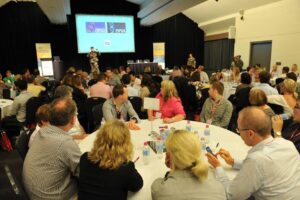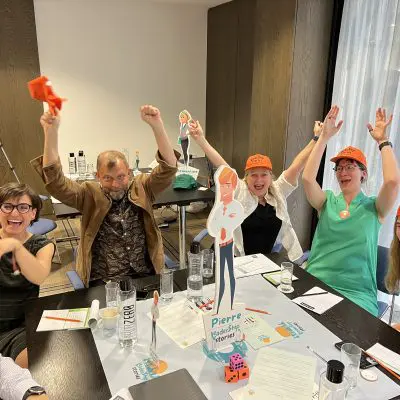Leadership is a driving force in any business, but which type of leadership is best? While there are many different approaches to leadership in the workplace, people-oriented leadership is undoubtedly one of the best forms if you want to unlock your employees’ true potential.
At its core, people-focused leadership is about putting people first and prioritizing interpersonal relationships so people feel valued and empowered to make their own decisions.
In our latest podcast episode, The Right Seat on the Bus, we spoke with Wendy Hanson—Co-Founder and Chief Culture and Community Officer of New Level Work.
Hanson discusses founding New Level Work, the importance of leaders, why people-oriented leadership is a key to success, and how to help leaders grow. One of her key points was the difference a good leader can make in employees reaching their potential, saying:
“Everybody’s gonna be on the bus, but you can be on the bus and be in the wrong seat. A people-oriented leader knows that, and a people-oriented leader brings out the best in the people they work for.”
In today’s blog, we’ll be diving deeper into the topic and providing actionable insights so you can improve your leadership and help your team become the best versions of themselves.
Understanding People-Oriented Leadership
To start, let’s cover the basics—what is people-oriented leadership? As the name suggests it’s ultimately about the people. People-focused leadership style means focusing on employees, their well-being, connection, collaboration, and their needs/growth.
Needs and growth in particular are very important. Employees want to feel valued and cared about. Focusing on their needs showcases that commitment and can make employees more engaged and satisfied.
So how does this differ from traditional leadership? Most traditional leadership styles focus on outcomes first and foremost. Deadlines and results take first priority over employees and their well-being.
People-oriented leaders on the other hand focus on employees, knowing that the results will come when employees are treated well and prioritized. These leaders are communicative and understanding, and really get to know their employees as individuals.
On the topic of what qualities should you look for in a people-oriented leader, Hanson said:
”[I look for] somebody who takes time to know who I am and know my strengths. A people-oriented leader helps people use their strengths…. So to look at the strengths of your people and really get to know who somebody is, that’s so you can put them in the right seat on the bus.”
Nurturing Growth and Productivity
Businesses are always looking for ways to boost productivity, and nurturing employee growth can be an incredibly effective way of accomplishing that.
Helping employees grow—such as through career advancement opportunities—gives them new skills that can make them more efficient, creative, and productive.
Here are a few strategies for nurturing employee growth, personally and professionally:
Communication. Communicating effectively is key. It can help you learn their strengths and weaknesses, get to know them, foster a positive work environment, and provide an opportunity for constructive feedback.
Break down silos. Silos can create division and gossip in the workplace. Encourage employees to talk with one another, share ideas, and help each other.
Support and encouragement. Growing is a lot easier when you have people around you who support and encourage you. So make sure you’re there for employees, helping them with their struggles and celebrating their successes.
Advantages of People Oriented Leadership Style
Now, let’s look at the advantages of a people-oriented leadership style.
One of the biggest benefits is improved engagement and retention. People are much more engaged when their workplace has a positive culture that uplifts and supports them. And with a culture like that, employees are much less likely to leave.
Another benefit is that it fosters collaboration and teamwork, resulting in more efficient and innovative teams. A people-focused leadership style encourages employees to work together to achieve their goals, which brings out employees’ creativity.
People-oriented leaders also help create a people-oriented company culture. That can have a massive impact on employees and teams.
With a people-oriented culture, employees know how strongly they are valued. They feel more comfortable and cared about at work. They are more likely to get help from others, open up about strengths and weaknesses, and care about those around them.
When creating a people-oriented culture, it’s important to remember the role of empathy in cultural transformation. Empathy is key to understanding others, prioritizing their well-being, and supporting employees.
How to Evaluate Employees’ Strengths and Weaknesses
As mentioned earlier, identifying strengths and weaknesses is a critical part of people-oriented leadership. However, knowing how to evaluate employees’ strengths and weaknesses can be a challenge.
So, let’s break things down and look at some effective ways to better understand your employees, including where they excel and where they struggle. With that knowledge, you’ll be able to place employees in “the right seat on the bus” to create more efficient teams.
Identifying Colleagues’ Strengths
First up is identifying colleagues’ strengths. What are colleagues’ strengths? They are simply things that your colleagues excel in such as organization, multitasking, problem solving, and more.
To identify these strengths you should consider observation, feedback, and open communication. This can help you better understand colleagues, where they perform best, and what they prefer.
Make time to observe colleagues and see what things they are exceptional at. Talk to them openly about their strengths and weaknesses, and provide constructive feedback to help them improve.
Another way to identify colleagues’ strengths and weaknesses is with team bonding. An event like Team Leadership DNA can help you learn more about your colleagues while also building bonds and improving communication skills.
Assessing Employment Strengths
Next is assessing employment strengths. Think of this as the specific skills and experiences that contribute to success in a particular job role.
For example, the best salespeople tend to be very outgoing, friendly, and confident. They may have had experiences when they were younger that required them to put themselves out there and develop their people/sales skills.
Evaluating these skills will help you get a more thorough understanding of employees, what roles suit them best, and how you can utilize their skills to the fullest.
Performance reviews and assessments play a big role here. They can be used to analyze employees’ performance, identifying areas of strength and areas for improvement.
From here, you can use that information to place employees in the best roles possible or provide training to help them improve upon their weaknesses.
Recognizing Employees’ Strengths
Now that you’ve assessed employees’ strengths, you can use that information to leverage those strengths among individual team members.
Aligning tasks and responsibilities with employee strengths can enhance job performance and satisfaction, resulting in more creative, innovative, and productive teams with higher retention.
So consider an employee’s strengths and use that to identify the best position for them. For example, say an employee is incredible when it comes to adaptability. You might place them in a role that is always changing and requires a lot of flexibility and a diverse skill set.
However, it’s important to communicate with employees and keep their goals and preferences in mind. Employees may excel at something they do not enjoy, and placing them in a position they excel in but don’t like can lead to lower satisfaction and burnout.
Try to balance their preferences with their skills. This can help ensure your team members are both productive and satisfied.
Dealing with Resistance and Driving Change
Many people are resistant to change, and driving change across an entire organization can be difficult. Dealing with this resistance is essential if you want to be successful.
Some of the key factors to keep in mind here are:
Empathy. Understanding where employees are coming from and why they resist change can help you more effectively address those concerns and drive change.
Communication. As with empathy, communication allows you to better understand employees. Talk openly about their concerns, support them, and show employees they can trust you.
Lead by example. People follow their leaders, and employees won’t embrace change if their leaders don’t. Set an example and show employees that you’re walking the walk.
Another option is team building. Team building can help open people up to change while also having fun and strengthening their skills. Breaking Barriers, for example, involves team members identifying their fears and barriers to growth, including resistance to change.
Retention Strategies with People-Oriented Leadership
Retention is a big focus for most businesses, and people-oriented leadership can help boost retention. People-focused leadership results in more satisfied and engaged employees, which in turn increases retention.
Support is incredibly important to increase retention. Supporting employees, especially when things go wrong, allows them to grow and flourish. Hanson noted this in our conversation when she said:
“We have to try things. We have to be able to take risks. And as a leader, you need to support that. And then not throw somebody under the bus if something goes wrong. We want to be able to support those things and give people opportunities to flourish.”
Another option for boosting retention is team building. Events like The Big Picture and The Do Good Bus bring your team together, make them feel part of a greater whole, build bonds, and ultimately help increase retention.
People Leadership for Everyone
People-oriented leadership is a very effective way to unlock employees’ potential, building stronger and more resilient teams that are more innovative and productive.
As with any change or shift in culture, that starts with leaders. They have to embody the company’s people-oriented culture and lead by example. They should foster communication, trust, and authenticity to show employees they are invested in putting people first.
Facilitating professional development training and team bonding events can help you get the most out of your team while also having fun. At TeamBonding, we put a fun spin on our events while focusing on specific takeaways that help teams grow.
So start walking the talk and embody the people-oriented culture and leadership you want to see. Take action and create an environment where employees support each other and thrive.
Get in touch with us to start your journey towards creating a better workplace with stronger, more resilient teams.















